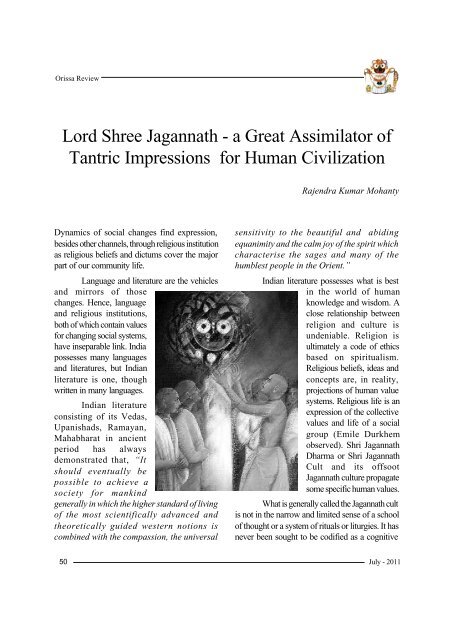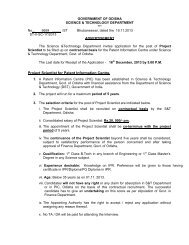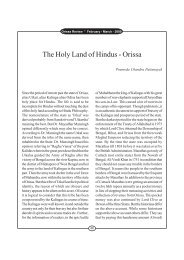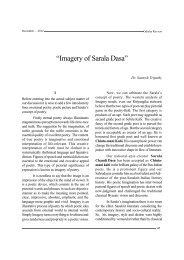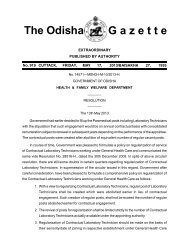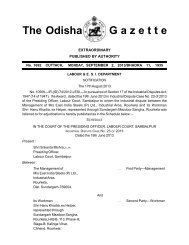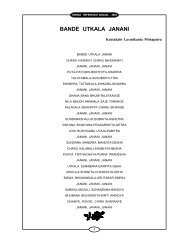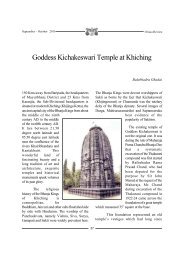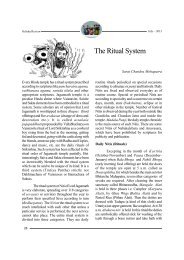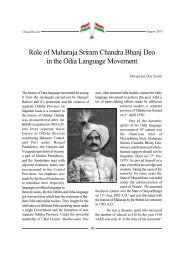Lord Shree Jagannath - a Great Assimilator of Tantric Impressions ...
Lord Shree Jagannath - a Great Assimilator of Tantric Impressions ...
Lord Shree Jagannath - a Great Assimilator of Tantric Impressions ...
Create successful ePaper yourself
Turn your PDF publications into a flip-book with our unique Google optimized e-Paper software.
Orissa Review<br />
<strong>Lord</strong> <strong>Shree</strong> <strong>Jagannath</strong> - a <strong>Great</strong> <strong>Assimilator</strong> <strong>of</strong><br />
<strong>Tantric</strong> <strong>Impressions</strong> for Human Civilization<br />
Dynamics <strong>of</strong> social changes find expression,<br />
besides other channels, through religious institution<br />
as religious beliefs and dictums cover the major<br />
part <strong>of</strong> our community life.<br />
Language and literature are the vehicles<br />
and mirrors <strong>of</strong> those<br />
changes. Hence, language<br />
and religious institutions,<br />
both <strong>of</strong> which contain values<br />
for changing social systems,<br />
have inseparable link. India<br />
possesses many languages<br />
and literatures, but Indian<br />
literature is one, though<br />
written in many languages.<br />
Indian literature<br />
consisting <strong>of</strong> its Vedas,<br />
Upanishads, Ramayan,<br />
Mahabharat in ancient<br />
period has always<br />
demonstrated that, “It<br />
should eventually be<br />
possible to achieve a<br />
society for mankind<br />
generally in which the higher standard <strong>of</strong> living<br />
<strong>of</strong> the most scientifically advanced and<br />
theoretically guided western notions is<br />
combined with the compassion, the universal<br />
50<br />
Rajendra Kumar Mohanty<br />
sensitivity to the beautiful and abiding<br />
equanimity and the calm joy <strong>of</strong> the spirit which<br />
characterise the sages and many <strong>of</strong> the<br />
humblest people in the Orient.”<br />
Indian literature possesses what is best<br />
in the world <strong>of</strong> human<br />
knowledge and wisdom. A<br />
close relationship between<br />
religion and culture is<br />
undeniable. Religion is<br />
ultimately a code <strong>of</strong> ethics<br />
based on spiritualism.<br />
Religious beliefs, ideas and<br />
concepts are, in reality,<br />
projections <strong>of</strong> human value<br />
systems. Religious life is an<br />
expression <strong>of</strong> the collective<br />
values and life <strong>of</strong> a social<br />
group (Emile Durkhem<br />
observed). Shri <strong>Jagannath</strong><br />
Dharma or Shri <strong>Jagannath</strong><br />
Cult and its <strong>of</strong>fsoot<br />
<strong>Jagannath</strong> culture propagate<br />
some specific human values.<br />
What is generally called the <strong>Jagannath</strong> cult<br />
is not in the narrow and limited sense <strong>of</strong> a school<br />
<strong>of</strong> thought or a system <strong>of</strong> rituals or liturgies. It has<br />
never been sought to be codified as a cognitive<br />
July - 2011
or philosophical structure. If it has a looseness <strong>of</strong><br />
organization as a system <strong>of</strong> philosophy, if its<br />
liturgical or religious concepts have not been seen<br />
against the backdrop <strong>of</strong> any particular Hindu sect<br />
or sects to assess its deviations and differences<br />
from them, it is because, like Hinduism it is more<br />
<strong>of</strong> a cultural matrix than a systematic school <strong>of</strong><br />
philosophy or religion.<br />
It is in this sense that <strong>Jagannath</strong> cult is not<br />
a religion or philosophy but is a broad mythology<br />
<strong>of</strong> culture. The mythic process is a learning device<br />
in which the unintelligible and the random are<br />
reduced to an intelligible pattern, howsoever<br />
complex.<br />
If it is a system <strong>of</strong> rituals, then it is based<br />
on rituals as anti structures—a syndrome <strong>of</strong><br />
symbols that embraces almost the entire gamut<br />
<strong>of</strong> human emotions and endeavours.<br />
<strong>Jagannath</strong> culture which started with the<br />
worship <strong>of</strong> <strong>Lord</strong> Shri <strong>Jagannath</strong> is the oldest living<br />
culture <strong>of</strong> the world. This has a unique human -<br />
value- system which needs to be highlighted.<br />
Shri <strong>Jagannath</strong> culture believes in<br />
universality and not in sectarianism. Shri <strong>Jagannath</strong><br />
is the God <strong>of</strong> the masses and hence Shri <strong>Jagannath</strong><br />
culture has been a mass culture. People <strong>of</strong> diverse<br />
faiths have worshipped <strong>Lord</strong> Shri <strong>Jagannath</strong>. He<br />
has been worshipped by the primitive tribals,<br />
Dravidians, Aryans, Hindus, Jains, Buddhists,<br />
Sikhs, Shaktas, Shaivites, Ganapatas and<br />
Vaisnavites.<br />
<strong>Jagannath</strong> Culture has been an elastic<br />
culture. Apart from influencing other cultures, it<br />
has incorporated into its fold the cultures <strong>of</strong> various<br />
faiths. Shri <strong>Jagannath</strong> is the Saura’s, wooden<br />
Deity without sense organs. Again, He is the<br />
Dravidian Deity with sense organs. He is the<br />
Purusottama <strong>of</strong> the Vedas and Darubrahma <strong>of</strong> the<br />
Brahmins. His image smacks <strong>of</strong> the influence <strong>of</strong><br />
July - 2011<br />
Orissa Review<br />
Sauras. His rituals remind us <strong>of</strong> Dravidian customs<br />
and His festivals are <strong>of</strong> Puranic origin. Of his<br />
Mantras (incantations) OUM is Vedic and Hrim,<br />
Slim, Klim are <strong>Tantric</strong>. His Kaibalya is <strong>of</strong> Jain<br />
origin and Nirmalya is <strong>of</strong> Shaiva origin. A close<br />
observation <strong>of</strong> His worship, attire, food, rites and<br />
rituals make us conclude that Shri <strong>Jagannath</strong><br />
culture has assimilated features from other<br />
cultures. It is devoid <strong>of</strong>, and free from all types <strong>of</strong><br />
regional narrowness. The essence <strong>of</strong> all great<br />
religious scriptures can be perceived in Shri<br />
<strong>Jagannath</strong> culture. By its wonderful power <strong>of</strong><br />
assimilation, it has effected a synthesis <strong>of</strong> all the<br />
important cultures <strong>of</strong> the world. It has adapted<br />
itself to the varying environments by effecting<br />
changes in its outer form, but its essence remains<br />
unchanged.<br />
Tolerance is an outstanding human value<br />
propagated by Shri <strong>Jagannath</strong> culture. It tolerates<br />
all races, religions, customs, and cultures. This<br />
tradition <strong>of</strong> tolerance is not an attitude <strong>of</strong><br />
indifference towards others. This is a fundamental<br />
postulate <strong>of</strong> <strong>Jagannath</strong> culture that every way <strong>of</strong><br />
life has its own contribution to human welfare. It<br />
is this positive approach to other groups and<br />
communities- this eschewal <strong>of</strong> doctrine that one’s<br />
way is absolutely right which gives to <strong>Jagannath</strong><br />
culture <strong>of</strong> toleration its special significance.<br />
It has respect for the faiths and beliefs <strong>of</strong><br />
others and a generous charity <strong>of</strong> understanding<br />
the approaches <strong>of</strong> other people to the problems<br />
<strong>of</strong> life. It stands for religious tolerance, coexistence<br />
<strong>of</strong> all religious communal harmony and<br />
international integration. Hence Shri <strong>Jagannath</strong> is<br />
worshipped by all irrespective <strong>of</strong> caste, creed,<br />
colour and community. Shri <strong>Jagannath</strong> culture aims<br />
at bringing the entire human community <strong>of</strong> the<br />
world into the ambit <strong>of</strong> one family.<br />
The messages <strong>of</strong> unity, equality, peaceful<br />
-coexistence and fraternity are nowhere so<br />
51
Orissa Review<br />
obvious as in <strong>Jagannath</strong> culture. Shri <strong>Jagannath</strong><br />
Cult is said to be a splendid synthesis <strong>of</strong> Hinduism,<br />
Buddhism, Jainism and <strong>Tantric</strong> rites.<br />
Shri <strong>Jagannath</strong> is not just a deity, He is an<br />
unique institution. Here primitive cults merge with<br />
different Indian religious denominations, i.e.<br />
Jainism, Buddhism, Saivism <strong>Tantric</strong>ism,<br />
Vaishnavism etc. It is a towering spirit <strong>of</strong> synthesis<br />
- an amalgam <strong>of</strong> effects <strong>of</strong> imposed cults and<br />
cultures. It has become a symbol that accepts and<br />
embraces and assimilates everything and yet<br />
maintains its own character.<br />
The gap between man and Divine has<br />
been bridged in <strong>Jagannath</strong> culture. Shri <strong>Jagannath</strong><br />
is a highly humanized Deity. He brushes his teeth,<br />
takes bath, changes His clothes, wears different<br />
robes and gold ornaments studded with precious<br />
stones to suit different festive occasions and<br />
seasons, enjoys fifty six varieties <strong>of</strong> food (bhoga)<br />
and thirty six kinds <strong>of</strong> services “Khatani niyoga"<br />
and retires to bed in night. Social functions, like<br />
Deepavali, Payashraddha and Holi are held inside<br />
the Shri <strong>Jagannath</strong> Temple. In Summer, the <strong>Lord</strong><br />
takes cool bath in water mixed with sandalwood<br />
paste. During ‘Nabakalebara’, He leaves his old<br />
body and assumes a new one. His old body is<br />
cremated (by way <strong>of</strong> laying in ditches dug for the<br />
purposes) in “Koili Baikuntha”. Here, the<br />
conception <strong>of</strong> God is human and majestic.<br />
Shri <strong>Jagannath</strong> culture does not admit <strong>of</strong><br />
any distinction with regard to caste, creed, colour<br />
and sex. Here the Brahmin Pandit <strong>Jagannath</strong> Dash<br />
could become the disciple <strong>of</strong> the non-Brahmin<br />
devotee. Balaram Das, Achyutananda, Kayastha<br />
by caste could become the friend <strong>of</strong> Chaitanya a<br />
Brahmin. It has allowed inter-caste marriage even<br />
in the hoary past. The marriage <strong>of</strong> the Brahmin<br />
Vidyapati and Lalitha, the Saura girl (Indigenous<br />
Tribal girl) bears testimony to this fact. The<br />
descendants <strong>of</strong> this couple are called ‘Daitas’ and<br />
52<br />
they have got the monopoly to serve the Deities<br />
during ‘Anabasara’ every year.<br />
The Car Festival perhaps symbolises this<br />
liminal phase <strong>of</strong> the ritual system in which all<br />
powerful Gajapati Kings sweep the areas and<br />
space around pedestal (where upon <strong>Lord</strong>s sit) <strong>of</strong><br />
all three chariots before the swirling multitude and<br />
the <strong>Lord</strong> <strong>of</strong> the Universe leaves the Brahmin<br />
Servitors dominated cloistered seclusion <strong>of</strong><br />
sanctum sanctorium, the litanies <strong>of</strong> the nearly<br />
secret forms <strong>of</strong> a aristocratic worship, to sit on<br />
the wooden chariot in full view <strong>of</strong> the humble and<br />
the lowly and listen to their heartfelt but strange<br />
orchestra <strong>of</strong> private prayers and supplications.<br />
The achievement <strong>of</strong> a degree <strong>of</strong><br />
statuslessness by abolishing in one sweep <strong>of</strong> a<br />
symbolism all the multiple personal, group and<br />
class identity is, perhaps, the most significant<br />
aspect <strong>of</strong> Shri <strong>Jagannath</strong> Culture. It is based on a<br />
concept <strong>of</strong> submissiveness and silence that lifts<br />
grace to the levels <strong>of</strong> a mutual contract between<br />
the God-head and the individual.<br />
Shri <strong>Jagannath</strong> culture aims at the<br />
upliftment <strong>of</strong> the poor, the fallen and the<br />
downtrodden. Its <strong>Lord</strong> Shri <strong>Jagannath</strong> is called<br />
‘Patitapabana’, the saviour <strong>of</strong> the fallen. Leaving<br />
behind His golden throne in ‘Bada Deula’ (His<br />
abode called Shri <strong>Jagannath</strong> Temple), He comes<br />
into ‘Badadanda’ (i.e, Grand Road connecting<br />
Shrimandira and Gundicha Temple (temporary<br />
abode during Car Festival). He comes into Grand<br />
Road twice in a year during car festival and<br />
Bathing Ceremony in order to be in the midst <strong>of</strong><br />
His devotees. This is a rare thing which is unique<br />
to this culture. In other cultures, devotees go to<br />
the temple or Shrine <strong>of</strong> the <strong>Lord</strong> to <strong>of</strong>fer their<br />
prayers. But here, the ever compassionate <strong>Lord</strong><br />
comes out twice a year to help His devotees and<br />
to be with them. Anybody can draw the ropes <strong>of</strong><br />
his chariots and can take ‘Mahaprasad’, the<br />
July - 2011
cooked food cooked in the sacred kitchen <strong>of</strong> Shri<br />
<strong>Jagannath</strong> inside the inner circle <strong>of</strong> the <strong>Great</strong><br />
Temple which has been <strong>of</strong>fered to Him.<br />
Humbleness is a cardinal human value in<br />
Shri <strong>Jagannath</strong> culture. Superiority complex and<br />
class-consciounsness have no place here. This<br />
culture ordains that no work is high or low. Here,<br />
the Gajapati king sweeps the chariots <strong>of</strong> the<br />
Deities. No doubt, this is a symbolic act. This act<br />
signifies that in Shri <strong>Jagannath</strong> Culture, there is<br />
no distinction between the powerful Sovereign<br />
King and the lowest <strong>of</strong> the low. Here, Shri<br />
<strong>Jagannath</strong> Himself imparts the lesson <strong>of</strong><br />
humbleness. During the ‘Pahandi’ (i.e, when the<br />
Deities are coming down the twenty two steps <strong>of</strong><br />
the temple one after another to sit in chariots) the<br />
<strong>Lord</strong> ungrudgingly tolerates the kicks and<br />
fisticuffs, slaps and derogatory comments <strong>of</strong> His<br />
Servitors. He behaves like a commoner, pledges<br />
his golden ring and quenches His thirst by taking<br />
curd from a milk-maid. He protests against the<br />
pride and arrongance <strong>of</strong> the Brahmin servitors /<br />
priests by accepting a coconut from the hand <strong>of</strong><br />
an untouchable, namely Dasia Bauri. He does not<br />
distinguish between the Gajapati king, His first<br />
Servitor among the rest <strong>of</strong> the Servitors and a<br />
‘Daitapati’ (a non Brahmin, but very close Servitor<br />
<strong>of</strong> the Deity) or between a Brahmin Servitor and<br />
an untouchable devotee.<br />
Naturally enough Orissa’s glorious<br />
Gajapati Kings treated their sprawling empire as<br />
no more than a Trust from Him, to be looked<br />
after in correct conscience, themselves being only<br />
its humble care-takers. When they returned<br />
victorious from military expeditions which were<br />
almost day to day affairs in those spacious times,<br />
they surrendered all their precious spoils to Him<br />
as rightly His. And to the innumerable feudal chiefs<br />
<strong>of</strong> the Empire, there was no greater moral curbs<br />
to any kind <strong>of</strong> treasonable thought or behaviour<br />
July - 2011<br />
Orissa Review<br />
against the Temporal Power, i.e, Central Power<br />
than the fear <strong>of</strong> dire divine retribution from the<br />
Omnipotent <strong>Lord</strong> <strong>of</strong> the Universe, i.e, Shri<br />
<strong>Jagannath</strong>.<br />
If the <strong>Lord</strong> spiritual thus helped and cooperated<br />
with Orissa’s <strong>Lord</strong> Temporal in the<br />
down-to-earth daily matters <strong>of</strong> administration, he<br />
was never any distance away also from Orissa’s<br />
frequent military expedition to neighboring land.<br />
If the Oriyas won glorious military triumphs over<br />
all their national enemies for over, twenty centuries<br />
continuously, king <strong>of</strong> the-then Orissa and Chiefs<br />
<strong>of</strong> military staff were wise enough not to arrogate<br />
all that glory entirely to their brawn, arms, courage<br />
or their skills in combat deployments, but<br />
attributed all that to the graces flowing out <strong>of</strong> Shri<br />
<strong>Jagannath</strong>’s Lotus Feet.<br />
The legend so widespread in Orissa and<br />
immortalised in painting, sculpture and poetry <strong>of</strong><br />
Shri <strong>Jagannath</strong> and His elder brother Shri<br />
Balabhadra, riding on black and white horses,<br />
ahead <strong>of</strong> king Purusottam’s Oriya army, marching<br />
to wreck vengeance on the impudent Prince <strong>of</strong><br />
Kanchi, is nothing but only the symbolic<br />
mystification <strong>of</strong> this universal feeling <strong>of</strong> the Oriya<br />
people that the great <strong>Lord</strong> Shri <strong>Jagannath</strong> was an<br />
active participant in all their national as well as<br />
personal affairs and that whatever prosperity that<br />
fell to them either as a nation or as individuals,<br />
was surely, merely His grace.<br />
Shri <strong>Jagannath</strong>, among all the Gods and<br />
Goddess <strong>of</strong> the Hindu Pantheon, is the God <strong>of</strong><br />
Democracy, par excellence. He alone, unlike all<br />
other divine celebrities <strong>of</strong> this great sub continent,<br />
was born out <strong>of</strong> the spiritual aspiration <strong>of</strong> the<br />
common man. He came to Orissa’s illiterate and<br />
unsophisticated Sabara tribals (Indigenous people<br />
residing in Orissa from hoary past as original<br />
inhabitants) in the dim past, when perhaps even<br />
the earliest chants <strong>of</strong> the great Rig Veda were not<br />
53
Orissa Review<br />
heard or known. He appeared also, on the same<br />
place <strong>of</strong> existence as that <strong>of</strong> His devotees, gladly<br />
accepting an open air habitat under a forest tree,<br />
along with crude food <strong>of</strong> His simple worshippers,<br />
He has kept up, through centuries, that kinship<br />
with the common folk in the midst <strong>of</strong> royal luxuries<br />
that were showered on Him later on, demanding,<br />
through the annual Car Festival, close association<br />
<strong>of</strong> the descendants <strong>of</strong> most pre-historical Sabaras<br />
devotees <strong>of</strong> His and remaining content with<br />
uncooked food such as the latter <strong>of</strong>fered Him in<br />
His forest hideout on a green look hillock on the<br />
bank <strong>of</strong> the river Mahanadi (Green look hillock<br />
is the present site <strong>of</strong> Shri <strong>Jagannath</strong> Temple which<br />
is in much higher height in comparison to<br />
peripheral sites, and the river Mahanadi in hoary<br />
past was flowing around this hillock and falling in<br />
lake Chilka, as geographical study by Tolemi has<br />
established) <strong>Lord</strong> Shri <strong>Jagannath</strong> stands as a<br />
spectacular symbol <strong>of</strong> National Integration, the<br />
free India’s most burning problem. Blue stone that<br />
the Sabaras had picked-up is supposed to be the<br />
fossilised un-burnt heart <strong>of</strong> Shrikrushna, thrown<br />
into waves <strong>of</strong> the western sea coast that had flown<br />
all along the Indian-sea board, to rest at last, on<br />
Odishan soil.<br />
In the above interesting myth, we clearly<br />
see an attempt at a spiritual link up <strong>of</strong> the entire<br />
Indian subcontinent from sea (western coast) to<br />
sea (eastern coast). If Shri <strong>Jagannath</strong> is Shrikrishna<br />
as well as Shri Ram, He also is the Buddha, as<br />
the Ninth Avtar (incarnation) <strong>of</strong> Shri Vishnu.<br />
In His daily worship, the blue-blooded<br />
Brahmin Servitor daily rubs his fair shoulders with<br />
the transformed, but still dark-skinned aboriginals<br />
(i.e, Daitas, Suddha Suara, etc.) thus putting into<br />
daily practice , the most vital line <strong>of</strong> king Ashoka<br />
in his famous Kalinga edicts- “saba manisa me<br />
puja”- all human beings are like my own dear<br />
children.<br />
54<br />
Shri <strong>Jagannath</strong> Culture always takes a<br />
positive view <strong>of</strong> life. It does not admit <strong>of</strong> the<br />
pessimistic thoughts <strong>of</strong> grief, suffering and death.<br />
It recommends staunch faith in the Divine. It<br />
teaches man to strive for the perfection <strong>of</strong> his soul<br />
by the sacrifice <strong>of</strong> His self. Material pursuits find<br />
no place in this culture. Here, a devotee does not<br />
ask for anything material. He prays for Divine<br />
love and grace.<br />
Shri <strong>Jagannath</strong> is the ocean <strong>of</strong> Mercy. By<br />
his Divine benediction He can liberate us and take<br />
us out <strong>of</strong> our mortal existence to the Divine abode.<br />
Unflinching faith in the <strong>Lord</strong> will kill all mundane<br />
desires and elevate the human soul. Shri <strong>Jagannath</strong><br />
culture teaches us that faith in the <strong>Lord</strong> and selfless<br />
service in the world will bring redemption to<br />
mankind.<br />
Shri <strong>Jagannath</strong> culture has effected unity<br />
in diversity and integrated human society with the<br />
help <strong>of</strong> human values that we have seen earlier as<br />
discussed in preceding paragraphs. This culture<br />
could come through many ups and downs.<br />
Surviving many onslaughts, it has consolidated its<br />
position and proved itself to be an effective and<br />
ideal culture.<br />
Human values such as tolerance, fellow<br />
feeling, unity, equality, fraternity, modesty and self<br />
sacrifice contained in Shri <strong>Jagannath</strong> Culture have<br />
sustained and will continue to sustain human<br />
civilization in our planet.<br />
Thus National Integration has been a<br />
reality in practice for centuries with Shri <strong>Jagannath</strong><br />
though it might be much talked <strong>of</strong> now at Guahati<br />
or Shri Nagar or at Chennai or at Delhi with<br />
hypocritical loudness.<br />
Rituals are as old as human civilization.<br />
When man made the first query about himself, he<br />
found to his utmost surprise that he was an<br />
admixture <strong>of</strong> some thing awful, ferocious and<br />
July - 2011
something benign and serene. The life force in him<br />
incited him to believe in a superior force behind<br />
the vast universe. This thought ultimately<br />
culminated, in “Pinda - Brahmanda” theory <strong>of</strong><br />
the Tantras and a unification <strong>of</strong> the supreme self<br />
and the individual self in the thought - “Yatha dehe,<br />
tatha Deve” (i.e whatever is in body is there in<br />
Deity)- forming the basis <strong>of</strong> the psychology <strong>of</strong> all<br />
worships. According to ‘Pinda- Brahmanda’<br />
theory, human body is a microcosm <strong>of</strong> the Universe<br />
or Brahmanda’. The “Visvasa ra Tantra’ says,<br />
‘Whatever is here (in this body) is also there (i.e,<br />
in the Universe). The five elements constituting<br />
the body are in no way different from the cosmic<br />
elements, i.e,. “Pancha Mahabhutas”, constituting<br />
the Universe. The body has a mind and the spirit<br />
and universal body has also a cosmic mind ritam<br />
comprising <strong>of</strong> three tendencies Ichha, Jnyana and<br />
Kriya, at the root <strong>of</strong> all evoluation and the Supreme<br />
Spirit, the Super Consciousness pervading the<br />
entire Universe. According to Hindu scriptures,<br />
the individual self may be able to realise the<br />
Supreme Spirit provided the enveloping mind and<br />
body are removed from it giving it a separate and<br />
finishing dimension otherwise, called “Avidya”.<br />
This Avidya also has its source in the Supreme<br />
Self as there cannot be anything in the Pinda which<br />
is not there in the Supreme Self or Brahma, is<br />
may or a finitising factor in the supreme<br />
consciousness which appears in the primordial<br />
cause <strong>of</strong> all ‘Prapancha’, the world or the<br />
Universe. Similarly mind in the individual body is<br />
the cause <strong>of</strong> all fetters <strong>of</strong> the Soul in its realization<br />
<strong>of</strong> the Brahman. The fetters are to be removed.<br />
And what is this way ?<br />
Man has pondered over it through all ages<br />
since the dawn <strong>of</strong> civilization and the Indian<br />
thinkers have shown that the path to know<br />
Brahman is to be Brahman. How ? The <strong>Lord</strong> is<br />
pure, infinite spirit, in this aspect to the relative<br />
world as its Creator, Maintainer and Destroyer.<br />
July - 2011<br />
Orissa Review<br />
Man is the selfsame spirit and in one aspect is<br />
immutable and in another is finitised by Mind and<br />
Matter. Mind, though an unconscious force,<br />
appears to be conscious as described by<br />
Vedantists, because it is the vehicle <strong>of</strong> Spirit which<br />
is consciousness itself. Once mind is detached<br />
from this body and finitising matter, it is merged in<br />
spirit and spiritualised as an iron rod becomes<br />
red-hot fire in a blacksmith’s furnace. Hence, for<br />
the realization <strong>of</strong> the Supreme Spirit, mind has a<br />
very vital role to play. When the individual self<br />
wants to concentrate on this Supreme Self, a mindray<br />
projected from the mind which goes forth to<br />
the object <strong>of</strong> worship, be it an image, or an idol,<br />
or a yantra, or a mere idea and takes its form,<br />
and returns and models the mind itself into the<br />
form <strong>of</strong> the object. Thus, by constant and<br />
complete attention on the form <strong>of</strong> the <strong>Lord</strong> without<br />
distraction, the mind transformed into the shape<br />
<strong>of</strong> the object in the form <strong>of</strong> the <strong>Lord</strong>. Thus, mind<br />
acquires the qualities <strong>of</strong> the <strong>Lord</strong> by such<br />
concentration being shaped into this image <strong>of</strong> the<br />
<strong>Lord</strong>.<br />
This is the basis <strong>of</strong> all worships, a method<br />
adopted by all devotees <strong>of</strong> the world whatever<br />
may be their caste, creed or birth, to realize God.<br />
And because mind and body have a common<br />
origin, the one as subject can know the other as<br />
object. Cognition is then recognition. The same<br />
power which has the capacity to veil itself can<br />
unveil itself to the seeker or the worshipper. How<br />
is that worship or Upasana to be made? Its first<br />
design is to secure that the mind shall have a good<br />
object as the symbol <strong>of</strong> God before it for<br />
concentration. In case <strong>of</strong> Upasana <strong>of</strong> <strong>Lord</strong> Shri<br />
<strong>Jagannath</strong>, object <strong>of</strong> Upasana or worship is <strong>Lord</strong><br />
<strong>Jagannath</strong> Himself. Taking into cognition <strong>of</strong> facts<br />
prevailing in Pre-Vedic and pre - Mahabharat in<br />
Udra Rajya or the modern day Orissa, it is the<br />
Lady deity which predominates into the worship<br />
<strong>of</strong> <strong>Lord</strong> <strong>Jagannath</strong> into a particular mode which<br />
is known as Dakshina Kalika.<br />
55
Orissa Review<br />
The mode <strong>of</strong> worship or Upasana <strong>of</strong> Shri<br />
<strong>Jagannath</strong> is unique and different from that <strong>of</strong> other<br />
Hindu Temples in North or South India. His Puja<br />
or worship has been well developed and<br />
systematised in a well designed process by<br />
coordinating the basics <strong>of</strong> Vedic, <strong>Tantric</strong>,<br />
Vaishnavite, Puranic streams.<br />
Hindu scriptures prescribe three main<br />
streams for Puja <strong>of</strong> Hindu Deities, i.e, Nigam ,<br />
Agam and Lokachara. Nigam is pure Vedic<br />
system. Agam is pure <strong>Tantric</strong> system and<br />
Lokachara is combination <strong>of</strong> both Nigam and<br />
Agam and some locally adjusted system prevalent<br />
for many years.<br />
Nigam system is guided by Karmakanda<br />
which concentrates mainly on “Japa”, “Jaaga” and<br />
“Yagyan” (fire sacrifice), where as Agam system<br />
is very much elaborate and contains innumerable,<br />
but prescribed (as in <strong>Tantric</strong> Literatures) systems<br />
<strong>of</strong> Puja. Agam means it is that which has come<br />
out <strong>of</strong> the mouth <strong>of</strong> Shiva, that which has entered<br />
into the mouth <strong>of</strong> Mahamaya Uma and that which<br />
is the opinion <strong>of</strong> Vishnu. <strong>Tantric</strong> system is a means<br />
for overall development <strong>of</strong> human beings and<br />
human society. Tantra aims to transform every<br />
action in life into a ritual, so that the individual<br />
performs every action and thought with a feeling<br />
<strong>of</strong> worship and awareness. The action <strong>of</strong> bathing,<br />
dressing, sitting for worship, <strong>of</strong>fering various<br />
symbolic sacrifices, sexual relations, stages <strong>of</strong><br />
development from conception in the womb, to<br />
birth and marriage etc. are transformed into<br />
worship. <strong>Tantric</strong> system has seven number <strong>of</strong><br />
“Acharas” (mythology <strong>of</strong> Upasana), out <strong>of</strong> which<br />
“Dakhinachara” as well as “Kulachara” are most<br />
suitable for Vaishnavite <strong>Tantric</strong> Upasana.<br />
In <strong>Tantric</strong> Upasana, Yantra and Mantra<br />
play major roles. “Yantra” is the body <strong>of</strong> the Deity.<br />
Puja <strong>of</strong> a Deity is required to be taken up on a<br />
Yantra, so Yantra is definitely very important<br />
56<br />
“Sarbeshameb Devanam Yantrapuja<br />
Prasasashyate” (“Gautami Tantra”) without a<br />
Yantra, Puja cannot be undertaken. If the<br />
“Yantra” is not known, then eight-petalled lotus<br />
is to be undertaken accordingly.<br />
“Mantra” is the soul <strong>of</strong> the Deity on a<br />
“Yantra” (“Mantra yate guptam Paribhasa te iti<br />
Mantrah”). Mantra is secret, to be learnt from a<br />
perfect “Guru” (Master). The sound <strong>of</strong> the<br />
Mantras being chanted combined with the power<br />
<strong>of</strong> the resolve made by the person performing the<br />
Puja, reaches the divine power that converts the<br />
chants into the desired blessings.<br />
Mantras in a gross level are special sound<br />
patterns. On a deeper sense, they are much more.<br />
Mantras are most important and considered as<br />
the essence <strong>of</strong> the practical Tantra. Mantras and<br />
Yantra (i.e., Mandals) are utilised in conjunction<br />
with each other to form a powerful combination.<br />
A Mandala, a Yantra or a Devata is the form <strong>of</strong><br />
consciousness. The Mandalas, or Yantras or<br />
Devatas are the manifested form, configuration<br />
<strong>of</strong> “Shakti”, while, the “Mantra” which is also<br />
“Shakti”, is the link between consciousness and<br />
form. This system applies to everything in the<br />
world around us. The visible form is the<br />
expression, while the Mantra is the vehicle <strong>of</strong><br />
expression. Mantra is the direct link with the<br />
beyond.<br />
Taking into cognition <strong>of</strong> all the historical,<br />
archaeological and Puranic facts into<br />
consideration which are available at least from<br />
first century AD, it can safely be stated that Shri<br />
<strong>Jagannath</strong> Upasana is nothing but a ‘<strong>Tantric</strong><br />
Upasana’ <strong>of</strong> Vajrayana Period (<strong>Tantric</strong> Buddhist<br />
rituals which originated from Orissa during 3rd /<br />
4th century and went on spreading to India. Tibet<br />
and beyond through the Guru Padmasambhaba<br />
who happened to be the son <strong>of</strong> King ascertic<br />
Indrabhuti, King <strong>of</strong> the then Sambalaka (modern<br />
July - 2011
day Sambalpur) which is amply proved from<br />
the seats <strong>of</strong> the idols which are Yantras <strong>of</strong> various<br />
type. <strong>Lord</strong> Shri <strong>Jagannath</strong> sits on Kali Yantra,<br />
Balabhadra on Tara-yantra, Subhadra on<br />
Bhubaneswari - Yantra and the Mantras adopted<br />
for their worship should also be studied. Though<br />
these Mantras have been widely corrupted by<br />
subsequent additions and interpolations, the basic<br />
Vija Mantras appear to be <strong>Tantric</strong> and not Vedic.<br />
The <strong>Lord</strong> Shri <strong>Jagannath</strong> is worshipped by the<br />
following Mantra. “Klim Krishnaya, Govindaya<br />
Gopijana Vallabhaya Svaha”. It is undoubtedly a<br />
fact that except the primary vija Mantra ‘Klim’,<br />
the other portion <strong>of</strong> the Mantra is a Chaitanitic<br />
addition whose creed overwhelmed the then<br />
Oriya religious thoughts and culture due to royal<br />
patronage at the time <strong>of</strong> Gajapati king Pratap<br />
Rudra Dev and naturally the seat <strong>of</strong> Oriya Culture,<br />
i.e, Shri <strong>Jagannath</strong> <strong>of</strong> Puri adopted the religion <strong>of</strong><br />
the king with consequential changes.<br />
What is this ‘Klim’ which is the Vija<br />
Mantra for worship <strong>of</strong> <strong>Lord</strong> Shri <strong>Jagannath</strong>?<br />
Actually, Klim is the Vija Mantra <strong>of</strong> Sakta Tantrik<br />
Deity Kali and very <strong>of</strong>ten <strong>Lord</strong> Shri <strong>Jagannath</strong><br />
has been described as ‘Dakshina Kalika’ (in<br />
‘Mahanirvana Tantra’).<br />
Influence <strong>of</strong> <strong>Tantric</strong> way <strong>of</strong> Puja in case<br />
<strong>of</strong> <strong>Lord</strong> Shri <strong>Jagannath</strong> can be well observed from<br />
various Nyasas such as “Sadanga-Nyasa”,<br />
“Keshavadi Nyasa”, “Shrikanthadi Nyasa”,<br />
“Kala-Nyasa”, “Matruka-Nyasa”, “Sodha-<br />
Nyasa” and “Mahasodha Nyasa” which are<br />
attributed in daily mode <strong>of</strong> worship <strong>of</strong> <strong>Lord</strong> Shri<br />
<strong>Jagannath</strong>.<br />
Moreover, “Panchasakhas” (five friends),<br />
i.e., Balaram Das, Ananta Das, Yasobanta Das,<br />
Achyutananda Das and <strong>Jagannath</strong> Das are all<br />
Vaishnavites and their presiding Deity is Shri<br />
<strong>Jagannath</strong> <strong>of</strong> Puri, Purusottam Khetra. But they<br />
are all devotees <strong>of</strong> <strong>Lord</strong> Shri <strong>Jagannath</strong> in a <strong>Tantric</strong><br />
July - 2011<br />
Orissa Review<br />
mode (i.e., Kaula- charies). We find mention <strong>of</strong><br />
Yantra, Mantra and Tantra in their literatures.<br />
According to them, <strong>Lord</strong> Shri <strong>Jagannath</strong> is both<br />
“Saguna Brahma” and “Nirguna Brahma”. Yantra,<br />
Mantra, Tantra are nothing but “Saguna Sadhana”.<br />
According to them, one can realise Shri <strong>Jagannath</strong><br />
in his own body by both Saguna Sadhana and<br />
Nirguna Sadhana which is famous as “Pinda -<br />
Brahmanda Tatwa or Theory” which has been<br />
delineated in earlier paragraphs.<br />
Besides, the following daily rituals would<br />
show that the articles <strong>of</strong>fered to the <strong>Lord</strong> are<br />
symbols <strong>of</strong> five M’s <strong>of</strong> the Tantra Dakshinachara<br />
worship. In the morning, cocoanut water is <strong>of</strong>fered<br />
to <strong>Lord</strong> Shri <strong>Jagannath</strong> and Madan Mohana<br />
(moveable representative Deity <strong>of</strong> Shri <strong>Jagannath</strong>)<br />
in a Kansya-Patra, i.e bell metal pot or water with<br />
Jaiphala thrashing in an earthen pot as a symbol<br />
<strong>of</strong> wine. This is also <strong>of</strong>fered during day’s <strong>of</strong>fering<br />
<strong>of</strong> Panktibhoga. Similarly <strong>of</strong>fering <strong>of</strong> black gram<br />
(biri) cakes admixtured with Hengu is made as a<br />
symbol <strong>of</strong> flesh <strong>of</strong>fering. Offering <strong>of</strong> various green<br />
Sakas (lettuce) with ginger (ada) and ‘hengu’ are<br />
made as a symbol <strong>of</strong> fish. Offering <strong>of</strong> various<br />
cereals are made as symbol <strong>of</strong> Mudra. At times,<br />
Mudra is identified with various gestures <strong>of</strong> hand<br />
while <strong>of</strong>ferings are made to the Deity. The last<br />
<strong>Tantric</strong> symbol <strong>of</strong> worship is Maithuna or<br />
copulation. This may appear odd but, it was<br />
symbolically represented by Mahari or Devadasi<br />
dances (till 1956) in the Shri <strong>Jagannath</strong> Temple at<br />
the time <strong>of</strong> sleep <strong>of</strong> the <strong>Lord</strong> at night. These dances<br />
were <strong>of</strong>fered to the <strong>Lord</strong> by an unmarried girl in a<br />
semiclad body in a trance position. The system is<br />
no more prevalent, as no unmarried girl is<br />
available who would remain unmarried for whole<br />
life in order to perform Devadasi Nrutya before<br />
<strong>Lord</strong> Shri <strong>Jagannath</strong> alone. Even <strong>Lord</strong>s are<br />
dressed like women by wearing Saries with veils<br />
head dresses <strong>of</strong> women and nose-rings at the time<br />
<strong>of</strong> worship.<br />
57
Orissa Review<br />
These methods <strong>of</strong> worship verily show<br />
that the <strong>Lord</strong> Shri <strong>Jagannath</strong> and the attendant<br />
Deities Shri Balabhadra and Shri Shubhadra are<br />
being worshipped in the <strong>Tantric</strong> way although time<br />
has admixtured it with Vedic Homa and Achamana<br />
and <strong>of</strong>fering <strong>of</strong> Arghya, Puspa and Chandana and<br />
other cosmetics and local adaptations <strong>of</strong> various<br />
<strong>of</strong>fering unprecedented in Vedas, Tantras and<br />
Puranas. But, invariably a question may arise as<br />
to why such <strong>of</strong>fering are made symbolically and<br />
not in actuality.<br />
The Tantras have explained it very<br />
elaborately. Worship (i.e, Upasana) may be<br />
‘Tamasika’ ‘Rajasika’ or ‘Sattvika’ in accordance<br />
with the competence <strong>of</strong> the worshippers who may<br />
be divided into three classes as ‘Pasus’, ‘Viras’<br />
and ‘Divyas’. The Pasus belong to the lower order<br />
<strong>of</strong> worhippers who are restrained from use <strong>of</strong><br />
‘Panchamakara Puja’ altogether. In other words,<br />
persons “Dakshinachara’ are ‘Pasus’ who can<br />
worship the Deities only with ordinary Upacharas<br />
but ‘Viras’ can worship the <strong>Lord</strong> with all five M’s<br />
<strong>of</strong> Madya (wine), Matsya(fish), Mamsa (Meat)<br />
and Mudra (cereals or articulations) and Maithuna<br />
(copulation). The individual Tantra Sadhakas<br />
could worship their ‘Istadevata’ with all these left<br />
ways <strong>of</strong> Sadhana. But such things were natuarally<br />
repulsive from social point <strong>of</strong> view and any Temple<br />
worship being social or community worship, all<br />
the base methods which are responsible for a<br />
human fall were transmitted to the outer Temple<br />
as a form <strong>of</strong> art or Temple decoration but kept as<br />
symbols in the <strong>Tantric</strong> worship suitable for Divyas<br />
or Kaulas. This also explains as to why there are<br />
large number <strong>of</strong> erotic pictures in the outer<br />
precincts <strong>of</strong> the Hindu Temple.<br />
In order to become a Kaula or Divya<br />
worshipper, a Sadhaka has to win over all the<br />
base qualities in human nature and regard them<br />
as mere objects <strong>of</strong> enjoyment (Bhukti) which<br />
58<br />
when sublimated gives Mukti (liberation) because<br />
the reality <strong>of</strong> the world is grounded in the Absolute.<br />
The body with all its base and finer qualities seems<br />
self same Absolute. The creative function<br />
(maithuna) being natural is not in itself culpable.<br />
There is no real antimony between Spirit and<br />
Nature which is an instrument for this realization<br />
<strong>of</strong> the spirit. The method borrows that <strong>of</strong> Yoga<br />
not to frustrate but to regulate enjoyment.<br />
The worship <strong>of</strong> <strong>Lord</strong> Shri <strong>Jagannath</strong> is<br />
such Divya form <strong>of</strong> worship made not by Stotriya<br />
Brahmins, nor by <strong>Tantric</strong> Viras, but Kaulas adept<br />
in the Vedas, the Tantras and the Puranas. The<br />
Brahmins <strong>of</strong> Orissa were all Kaulas and each had<br />
got a Kula-Devata long before ‘Radhakrishna’<br />
worship stepped into this area by Chaitanites.<br />
In “Peetha Nirnaya”, “Mastya Purana” and<br />
“Kalika Purana”, Shri Purusottam Puri Kshetra<br />
has been described as “Shaktapeetha” and its<br />
Presiding Deity Shri <strong>Jagannath</strong> along with the lady<br />
Deity Mahamaya Vimla <strong>of</strong> Shri Purusottam Puri<br />
have been described as Bhairaba and Bhairabi.<br />
This has been specifically described in the<br />
Thirteenth Shloka <strong>of</strong> “Mahapitha Nirupanam” that<br />
this Shakti is Mahamaya Vimla and Bhairaba is<br />
Shri <strong>Jagannath</strong>. “Mastya Purana” is said to be<br />
written before 3rd. Century. Similarly “Kalika<br />
Purana” which is written before 950 AD<br />
categorically says “Uddiyan Peetha” is oldest<br />
Shakta and Tantra Peetha where Sadhakas were<br />
to do Tantra Sadhana. Similarly in “Bishnu<br />
Purana” which is settled to have been before 4th<br />
century categorically mentions Udra Peetha or<br />
Uddiyana Peetha which existed near Eastern<br />
Orissa at place called Puri. Similarly in “Bruhannila<br />
Tantra” it is clearly mentioned that Puri Purusottam<br />
Kshetra is famous for its “Nila Parbat <strong>Tantric</strong><br />
Peetha”. Similarly in “Gyanarnaba Tantra” we see<br />
that Puri Purusottam Kshetra has been described<br />
as Shri Kshetra Mahalaxmi Peetha and<br />
July - 2011
Khetreshwari is Maa Vimala and its very existence<br />
is due to this being oldest “Uddiyana Tantra<br />
Peetha”. Similarly we see in “Peetha Nirnaya” that<br />
Shri <strong>Jagannath</strong> and Mahamaya Vimala have been<br />
described as Bhairab and Bhairabi. Similarly in a<br />
manuscript in the tittle ‘Bimala Saparyaa”<br />
preseved in State Museum, Bhubaneswar<br />
scripted in 9th century, Mahamaya Vimla is the<br />
presiding lady Deity <strong>of</strong> Uddiyan Tantra Peetha<br />
and left Pada <strong>of</strong> “Sati” has fallen and hence it is<br />
famous as “Sati Pada Peetha” and presiding Deity<br />
is Shri <strong>Jagannath</strong>.<br />
Thus, it can safely be conjectured that<br />
Puri Purusottam Kshetra is primarily a Sakta<br />
Tantra Peetha and its presiding lady Deity is<br />
Mahamaya Vimala and Presiding Deity is Shri<br />
<strong>Jagannath</strong>.<br />
On the basis <strong>of</strong> archaeological evidence,<br />
the concept <strong>of</strong> Sakti can be traced to Indus Valley<br />
Civilization, i.e, it is pre-Vedic. The Streak <strong>of</strong><br />
Saktism can be found in all religions or religious<br />
denominations <strong>of</strong> India. It had its place in Orissa<br />
also, and its hold on the population continues to<br />
the present day. Practically all the religions or<br />
religious denominations that came to Orissa had<br />
to come to terms with Saktism as female deities<br />
<strong>of</strong> the Sakti Cult are worshipped even now in the<br />
society. Royal patronage has been there from 8th<br />
to 11th century in Orissa.<br />
Goddess Vimala holds a very important<br />
position in Shri <strong>Jagannath</strong> Temple Puri. She is<br />
addressed as Peetheswari i.e., Goddess <strong>of</strong> the<br />
land (Pitha). Puri or Purusottama Kshetra has a<br />
great antiquarian value in art, architecture,<br />
literature, religion and tradition. For centuries, it<br />
has been the principal religious centre <strong>of</strong> the<br />
Hindus; one among the four Dhams <strong>of</strong> Hinduism<br />
alongwith Dwarika, Badrinath and Rameswaram.<br />
This holy city has been variously referred to in<br />
ancient Sanskrit texts and Puranas as Nilachala,<br />
July - 2011<br />
Orissa Review<br />
Niladri, Nilagiri Purusottama Kshetra, Srikshetra.<br />
and Sankhakshetra. Even in Rig Veda, Yogitantra<br />
and Kalika Purana, Puri is referred as<br />
Purusottama. We find syncretisms <strong>of</strong> different<br />
cults; such as Vaishnavism, Buddhism, Jainism,<br />
Saivism, Saktism etc. in <strong>Jagannath</strong> Cult. In the<br />
daily rituals and practices <strong>of</strong> the <strong>Jagannath</strong> temple,<br />
Jaina, Vaishnavite, Buddhist, Saivite, Tantrik<br />
influences are found.<br />
Faminine Sakti commands as much<br />
respect as does Vishnu or Siva. Saktism is a<br />
popular religious cult <strong>of</strong> kings and people <strong>of</strong><br />
Orissa from very ancient time to the modern age.<br />
In Sakti literature, Orissa is well known as<br />
Odrapitha. The city <strong>of</strong> Viraja (i.e, the present day<br />
District Headquarters Town Jajpur), Ekamra (i.e,<br />
the present day old Bhubaneswar part <strong>of</strong> Capital<br />
city <strong>of</strong> Orissa) and Puri (Holy city as well as Dist.<br />
Town <strong>of</strong> Puri Dist.) were notably early Sakta Pitha<br />
in Orissa as attested from various literary,<br />
archaeological as well as folk traditions. Although<br />
Purusottama Kshetra came to be recognised as<br />
a great centre <strong>of</strong> Vaisnavism, particularly during<br />
the reign <strong>of</strong> Imperial Gangas, it was also a centre<br />
<strong>of</strong> Saktism <strong>of</strong> India as attested from literature,<br />
tradition and archaeological remains.<br />
In the tantric lore, <strong>Lord</strong> <strong>Jagannath</strong> is<br />
considered to be a Bhairava and Vimala is<br />
worshipped as Mahadevi. In Devi Bhagavata,<br />
Vimala is considered to be a Kshetra Sakti.<br />
Matsya Purana refers to Purusottama Kshetra as<br />
a Sakta Pitha, with its presiding goddess Vimala.<br />
Vamana Purana refers to Purusottama alongwith<br />
Viraja as a sacred pilgrimage centre. <strong>Tantric</strong><br />
literature “Rudra Yamala” composed in 950 A.D.<br />
glorifies <strong>Jagannath</strong>a as adorning the Mahapitha;<br />
Kalika Purana refers to Odrapitha as a famous<br />
Saktipitha which was the celebrated seat <strong>of</strong><br />
goddess Katyayani and God <strong>Jagannath</strong>. Tantra<br />
Yamala, another <strong>Tantric</strong> work refers to <strong>Jagannath</strong><br />
59
Orissa Review<br />
as the presiding deity <strong>of</strong> Purusottama Kshetra in<br />
Utkala. The list <strong>of</strong> 108 Pithas is found in the<br />
“Pranatosini Tantra”. In the Puranic list <strong>of</strong> 108<br />
names <strong>of</strong> the Mother Goddess in Namastottara<br />
Sata, we come accross the expression. ‘Vimala<br />
Purusottam”. In the list <strong>of</strong> Mahapithas and<br />
Upapithas given by the author <strong>of</strong> Siva Charita<br />
also we come across Nila Parvata or Nilachala,<br />
an Upapitha where Vimala is the presiding Devi<br />
and <strong>Jagannath</strong> is Bhairava. Thus many <strong>Tantric</strong><br />
Texts, recognise Puri as Pada Pitha where the<br />
foot portion <strong>of</strong> the Sati fell at Purusottama Kshetra<br />
as per the “Dakshyajna” episode.<br />
If we take into account the recent<br />
discovery <strong>of</strong> the stone images <strong>of</strong> <strong>Jagannath</strong>,<br />
Balabhadra and Subhadra alongwith Daksina<br />
Kalika dated to 9th century A.D. by scholar<br />
Sansanka Sekhar Panda at Tetelkhunti in the<br />
district <strong>of</strong> Balangir (Orissa), it allures us to<br />
conclude that in these forms the <strong>Jagannath</strong> Triad<br />
were worshipped in the upper Mahanadi valley<br />
in the 9th century A.D. In the “Mahanirvana<br />
Tantra”, <strong>Jagannath</strong> has been identified with<br />
Dakshina Kalika (Tara Saksyat Sulapani<br />
Subhadra Bhubaneswari / Niladroutu <strong>Jagannath</strong>a<br />
Saksyat Daksina Kalika).<br />
The worship <strong>of</strong> holy trinity in <strong>Shree</strong><br />
<strong>Jagannath</strong> Temple, represents the inter relation<br />
between Vaishnavism and Saktism. Devi<br />
Subhadra enshrined between <strong>Lord</strong> <strong>Jagannath</strong> and<br />
Balabhadra is no other than Ekanamsa, one <strong>of</strong><br />
the manifestation <strong>of</strong> Durga or Katyayani. In<br />
“Brahma Purana”, Ekanamsa is identified with<br />
Katyayani. In “Purusottama Mahatmya” <strong>of</strong><br />
“Skanda Purana”, Subhadra has been identitified<br />
as the Sakti <strong>of</strong> Vishnu, Krishna as well as sister<br />
<strong>of</strong> Krishna. It is interesting to note here that<br />
Ambika, an aspect <strong>of</strong> Durga appears first as<br />
Rudra’s sister and then as consort. So there is<br />
some similarity between the cult <strong>of</strong> Durga and the<br />
60<br />
cult <strong>of</strong> Subhadra. Devi Subhadra has been<br />
regarded as Parasakti, Yogamaya, Kampilya<br />
Vasini, Ekanamsa, Bhubaneswari, Mahalakshmi<br />
and also in many other forms <strong>of</strong> the supreme power<br />
<strong>of</strong> the world. She is worshipped in Bhubaneswari<br />
Mantra (Hrim) which implies that she is the Sakti<br />
<strong>of</strong> <strong>Lord</strong> <strong>Jagannath</strong>. Learned Scholars B.C.<br />
Pradhan and Herman Kulke hold the view that<br />
the iconography <strong>of</strong> Subhadra resembles that <strong>of</strong><br />
the iconography <strong>of</strong> the Goddess Khambesvari.<br />
So Subhadra existed in the <strong>Jagannath</strong> triad atleast<br />
during the Somavamsi period. She was a Sakta<br />
deity and was adored as Katyayani, Durga and<br />
Bhadrakali. The Sakta element in Subhadra is well<br />
indicated even today.<br />
The Parsva Devatas in Subhadra’s chariot<br />
are Durga and Chamunda. She is also worshipped<br />
daily in Bhubaneswari Mantra. Thus it seems that<br />
the central placement <strong>of</strong> Subhadra in the <strong>Jagannath</strong><br />
trinity is an indication <strong>of</strong> pivotal position <strong>of</strong> Sakti<br />
in the great Tantra Pitha <strong>of</strong> Puri. Learned scholar<br />
Sasanka Sekhar Panda has opined that Goddess<br />
Samalei <strong>of</strong> Sambalpur is worshipped in the same<br />
Bhubaneswari Mantra as in the case <strong>of</strong> Subhadra<br />
in Sri <strong>Jagannath</strong> temple, Puri. The uniconic form<br />
<strong>of</strong> goddess Samalei (the presiding Deity <strong>of</strong><br />
Sambalpur in western part <strong>of</strong> Orissa) like the<br />
present anthropoid form <strong>of</strong> Subhadra seems to<br />
be identical. Samalei initially worshipped by the<br />
tribals and later absorbed into Hindu fold by the<br />
Somavamsis, who were ruling over Orissa from<br />
the upper Mahanadi valley from Subarnapura<br />
(western part <strong>of</strong> Orissa) in 9th - 10th century A.D.<br />
The temple <strong>of</strong> Goddess Vimala, an<br />
important Sakta Shrine is located in the south<br />
eastern corner <strong>of</strong> <strong>Lord</strong> <strong>Jagannath</strong> temple. She is<br />
also known as <strong>Shree</strong>kshetresvari. On examination<br />
<strong>of</strong> ritual pattern connected with <strong>Jagannath</strong> temple,<br />
it is observed that the role <strong>of</strong> Vimala is more<br />
important than that <strong>of</strong> Lakshmi, because, rituals<br />
July - 2011
<strong>of</strong> Vimala are based on tantric rituals, where as<br />
that <strong>of</strong> Lakshmi is Vaishnavite in character. “Tantra<br />
Chudamani” describes Vimala as Bhairavi and<br />
<strong>Jagannath</strong> as Bhairava. It is pertinent to mention<br />
here that the Bhogas <strong>of</strong> <strong>Lord</strong> <strong>Jagannath</strong> become<br />
Mahaprasad after these are <strong>of</strong>fered to Goddess<br />
Vimala. Learned Scholar Herman Kulke has<br />
drawn our attention to the representation <strong>of</strong><br />
<strong>Jagannath</strong> in the form <strong>of</strong> Ajaikapada Bhairava on<br />
a sculptural panel <strong>of</strong> the temple <strong>of</strong> Konark. The<br />
above quoted literary and sculptural evidences<br />
very well indicate that Puri was a centre <strong>of</strong> <strong>Tantric</strong><br />
form <strong>of</strong> Saivism and Saktism where <strong>Jagannath</strong><br />
was worshipped as Bhairava and Vimala as his<br />
Sakti (Odresu Vimala Saktin <strong>Jagannath</strong>astu<br />
Bhairavah).<br />
Both Vaishnavite and Sakta rites are<br />
found in the ritual pattern <strong>of</strong> Vimala. Earlier in the<br />
dead <strong>of</strong> the night <strong>of</strong> Vijaya Dasami <strong>of</strong> Dasahara,<br />
animal sacrifice was performed. Later on this<br />
practice was stopped but continued in guise <strong>of</strong><br />
animal sacrifice made in dead <strong>of</strong> night, head<br />
portion is <strong>of</strong>fered to Vimla and body portion to<br />
Kakudi Khai, a representive lady Deity <strong>of</strong><br />
Mahamaya Vimala in the outskirt. with the<br />
imposition <strong>of</strong> Vaishnavite rites. The tantric rites <strong>of</strong><br />
Dakshinachara, Vamachara and Kaulachara are<br />
performed here.<br />
Deep influence <strong>of</strong> tantric rites can be seen<br />
in the Yantra <strong>of</strong> Purusottama. The Yantra consists<br />
<strong>of</strong> an eight petalled lotus with the Vijamantra<br />
‘Klim’ in the centre. The priests <strong>of</strong> <strong>Lord</strong> <strong>Jagannath</strong><br />
temple first propitiate <strong>Lord</strong> Purusottama with<br />
Goddess Lakshmi and then worship eight Sakties<br />
<strong>of</strong> Vishnu, namely Vimala, Utkarsini, Yajna, Kriya,<br />
Yoga, Prathvi, Satya and Isana. Vimala is regarded<br />
as one <strong>of</strong> the eight Chandis <strong>of</strong> Purusottama<br />
Kshetra. The other seven Chandis are<br />
Ramachandi, Harachandi, Baselichandi,<br />
Alamchandi, Dakshinachandi and Jhadesvari. In<br />
July - 2011<br />
Orissa Review<br />
the traditional rites, Vimala is invoked as the Maya<br />
Sakti <strong>of</strong> <strong>Jagannath</strong>, Kriya Sakti <strong>of</strong> Balabhadra<br />
and Ichha Sakti <strong>of</strong> Subhadra. She is regarded as<br />
the consort <strong>of</strong> Balabhadra.<br />
Durga Madhava Rath Yatra<br />
Every year, the Car Festival <strong>of</strong> <strong>Lord</strong><br />
<strong>Jagannath</strong>, Balabhadra and Devi Subhadra is<br />
celebrated with pomp and ceremony in the month<br />
<strong>of</strong> Asadha (June and July) at Puri. But few people<br />
know about another car festival at Puri that takes<br />
place in the month <strong>of</strong> September- October,<br />
popularly known as Durga Madhav Rath Yatra<br />
or Sakta Gundicha Rath Yatra. This festival begins<br />
on the 9th day <strong>of</strong> Dasahara Puja and ends on the<br />
day <strong>of</strong> Dasahara. The festivals centres round two<br />
deities, i.e. Durga, a Sakta deity and Madhava, a<br />
Vashnavite deity. In Purusottama Kshetra <strong>Lord</strong><br />
<strong>Jagannath</strong> and Goddess Vimala are regarded as<br />
Madhava and Durga respectively. Goddess<br />
Durga is worshipped in the inner sanctum <strong>of</strong> main<br />
temple near the Bhandarghar. The deity <strong>of</strong><br />
Madhava is worshipped on the left side <strong>of</strong> Sri<br />
<strong>Jagannath</strong> on Ratna Simhasana in the inner<br />
sanctum. He is also known as young Purusottama<br />
and joins the festival on behalf <strong>of</strong> <strong>Lord</strong> <strong>Jagannath</strong>.<br />
The festival begins with Sahasra Kumbha<br />
Abhiseka on the dark fortnight <strong>of</strong> Aswina. After<br />
being permitted by Devi Subhadra and <strong>Lord</strong><br />
<strong>Jagannath</strong>, Goddess Durga comes out to sit on<br />
Somanath Mandap to take bath with thousand<br />
pots <strong>of</strong> purified and scented water and then <strong>of</strong>fered<br />
Puja. The deity <strong>of</strong> Madhava also after getting<br />
permission from <strong>Lord</strong> <strong>Jagannath</strong>, leaves Ratna<br />
Simhasana and joins Goddess Durga. Both the<br />
deities are tied together near the Bhandarghar and<br />
after getting permission from <strong>Lord</strong> <strong>Jagannath</strong>, they<br />
are taken to the temple <strong>of</strong> Goddess Vimala, who<br />
also is <strong>of</strong>fered ceremonial bath and Puja. On the<br />
ninth day <strong>of</strong> Dasahara, both the deities are taken<br />
together in a chariot to Narayani temple near<br />
61
Orissa Review<br />
Dolamandap Sahi <strong>of</strong> Puri town. There they are<br />
<strong>of</strong>fered Puja and Prasad at night. They return again<br />
to Srimandir. This festival continues for sixteen<br />
days and occupies a prominent place in the twelve<br />
festivals <strong>of</strong> <strong>Lord</strong> <strong>Jagannath</strong>.<br />
Since early medieval period, Durga<br />
Madhava cult is very popular in Orissa. Madhava<br />
is a compound <strong>of</strong> two words. i.e. Ma (Mother)<br />
and Dhava (Father). So Madhava implies both<br />
the combination <strong>of</strong> Mother (Sakti) and Father<br />
(Purusa). Durga Madhava worship can be found<br />
in the Madhavananda temple in the Prachi valley.<br />
Saptamatrukas, Dasha Mahavidya<br />
Upasana and 64 Yogini Upasana and its<br />
relationship with <strong>Lord</strong> Shri <strong>Jagannath</strong> are<br />
delineated as hereunder.<br />
Purusottama Kshetra as a significant<br />
Saktapitha for the worship <strong>of</strong> Saptamatrukas is<br />
further known from the archaeological evidences.<br />
A group <strong>of</strong> Saptamatrukas, made <strong>of</strong> chlorite stone<br />
is found near the Markandesvar tank at Puri. Here<br />
all the sculptures, except Chamunda are<br />
associated with babies. The artist has taken<br />
maximum care to depict the celestial smile in the<br />
facial expression rather than showing them as war<br />
goddess. These Matrukas are assigned to the<br />
epoch <strong>of</strong> the Somavamsis. It is the definite<br />
evidence to indicate that Puri was well known as<br />
a Saktipitha by the 9th and 10th centuries A.D.<br />
According to Madalapanji (chronicle maintained<br />
in Shri <strong>Jagannath</strong> Temple, Puri from atleast-7th<br />
century A.D.), the Saptamatruka temple was<br />
constructed by one Bhimakeshari <strong>of</strong> Keshari<br />
Dynasty.<br />
Tantra is known to be the secret<br />
knowledge or doctrine, because <strong>of</strong> its complex<br />
and esoteric character <strong>of</strong> the rituals and technical<br />
character <strong>of</strong> the terminology. The learned<br />
commentator Bhashkaracharya on “Lalita<br />
Sahasra Nama” described, if “Devi” as Vidya<br />
62<br />
liberates, by her Maya, she also binds. Hence,<br />
Vidya and Maya or Avidya are two aspects <strong>of</strong><br />
Tantra Goddess “Mahavidya”. “Devi” as<br />
Sarvatantra- Mayi and Sarvatantrarupa is Vidya.<br />
She is the destroyer <strong>of</strong> Avidya, which veils the<br />
Reality. Both Maya and Vidya reside in the <strong>Lord</strong><br />
as His Saktis, just like shade and light <strong>of</strong> the Sun<br />
and are respective causes <strong>of</strong> bondage and<br />
liberation. Vidya is also one <strong>of</strong> the six forms <strong>of</strong><br />
“Aiswarya” or glory which pertains to <strong>Lord</strong> as<br />
“Bhagavan” This <strong>Lord</strong>, though associated with<br />
Maya is not Himself subject to Maya.<br />
Tantra has equated this <strong>Lord</strong> with<br />
“Mahavidya” having both the aspects <strong>of</strong> Vidya<br />
and Avidya and by worshipping “Mahavidya”, the<br />
“Mayika” or Avidya aspect grants the “ Sadhaka<br />
Bhukti i.e., all worldly pleasures and “Vidya”<br />
aspects grant him “Mukti” or liberation. She is “<br />
Bhukti Mukti Karini.” This “Devi Mahavidya” is<br />
“Chidghana samudbhuta”, as narrated in Tantra<br />
Sastra called “Lalita Sahasra Nama.” She is<br />
substance “Ichha” (will or desire) “jnana”<br />
(knowledge) and “Kriya” (action). Thus “Vidya”<br />
as Jnana” is only one aspect <strong>of</strong> this “Supreme<br />
Devi”.<br />
According to the Hindu cosmology,<br />
“Jiva” controlled by the bonds <strong>of</strong> “Karman”<br />
otherwise known as “Avidya”, takes birth in<br />
different “Yonis” and dies eighty-four lakhs <strong>of</strong><br />
times. By the direction <strong>of</strong> “Yama”, it goes to the “<br />
Brahma Loka” and on its return from there,<br />
obtains, the human body and by the Grace <strong>of</strong><br />
“Brahmamayi” secures from a good Guru<br />
initiation in the “Mantra” <strong>of</strong> “ Mahavidya” and<br />
knowledge <strong>of</strong> the truth. There after the “Jiva” gets<br />
the supreme liberation and by the Grace <strong>of</strong> “<br />
Mayavidya” has not to return, so long as the<br />
Universe endures.<br />
This “Devi Mahavidya” according to<br />
Tantra is “Chinmayee”, i.e., infinite and eternal<br />
July - 2011
intelligence. Thus, “She” is “Sat”, “Chit” and<br />
“Ananda”. “Chit or consciousness in the<br />
“Supreme Vidya aspects <strong>of</strong> Brahman or “ Brahma<br />
Swarupini.” Vidya, who is the sole first cause in<br />
“Samsara” (world) both <strong>of</strong> bondage and<br />
liberation, is the creatrix <strong>of</strong> all creators.<br />
Thus, “Mahavidya Principle” has<br />
synthesized both Vidya and Avidya. The basic<br />
concept behind this synthesis is that by the will to<br />
separate life from “That” (Parama) Siva, which,<br />
while itself a manifestation <strong>of</strong> the “Brahma mayi”<br />
is overcome by Her as “ Mahavidya” and because,<br />
then only can “Jiva” enjoy Her. Thus, “Parama”,<br />
the absolute consciousness is “Sat”. The<br />
consciousness force in the Supreme Being “Sat”<br />
is known as “Mahavidya” without which there is<br />
no difference between Being and Non-Being.<br />
This consciousness-power in the Supreme a<br />
logical Being flows to creation for “Ananda”<br />
(Bliss), in three streams i.e., “Ichha”, “Kriya” and<br />
“Jnana” symbolically represented by the three<br />
premier Mahavidya Kali, Tara and Tripura<br />
Sundari/ Shodashi.<br />
Mahavidya is the great Sakti. She is<br />
“Maya” because it is Her “Maya” which produces<br />
“Samsara” (world). As <strong>Lord</strong> <strong>of</strong> “Maya” She is<br />
“Mahamaya”. “Mahamaya” without “Maya” is<br />
“Nirguna” and with “Maya” is “Saguna”. Maha<br />
Devi is “Avidya”, because she binds and “Vidya”<br />
(knowledge), because she liberates and destroys<br />
“Samsara”. She is “Prakruti” and as existing<br />
before creation is the “Adya (primordial) Sakti”.<br />
She is also the “Vachaka-Sakti”, or “chit” itself.<br />
“Sakti” or “Mahadevi” is this “Brahman” revealed<br />
in its mother aspect (Sri-Mata) as creatrix and<br />
nourisher <strong>of</strong> the world.<br />
We find that “Hindu polytheism”<br />
describes number <strong>of</strong> “Mahavidya” as ten.<br />
“Parasakti” or “Consciousness power” has got<br />
three aspects, “Icchaa”, “Kriya” and “Jnana<br />
July - 2011<br />
Orissa Review<br />
Sakti” before She assumes “Mayasakti” to create<br />
“Prapancha” (Universe). These three aspects are<br />
“Suddhavidya tatwa” and in Sakti-<strong>Tantric</strong><br />
terminology, “Mahavidya Kali, Tara and Sodashi<br />
or Tripura Sundari”. Hence, three Deities belong<br />
to “Mahavidya” proper and other seven, namely,<br />
Bhuvaneswari, Dhumavati, Vagala, Matangi and<br />
Kamalatmika” are latter additions representing<br />
some basic principles <strong>of</strong> creative power. Ten<br />
Mahavidyas represent stages in which “Sakti”<br />
manifests Herself and the stages in which she<br />
withdraws the creation to Herself and other stages<br />
exhibiting preservation <strong>of</strong> the creation. But formally<br />
each individual “Mahavidya” is the basic<br />
representation <strong>of</strong> all these three aspects as<br />
embodiments <strong>of</strong> “Triguna” responsible for the<br />
“Nama rupa” universe. It is also predominant<br />
consciousness holding our actions and directing<br />
them in accordance with our feelings and<br />
realisations.<br />
This is the functional aspect <strong>of</strong> all “Mahavidyas”.<br />
The above three aspects <strong>of</strong> “Para Sakti”<br />
is described as “Ichha”, “Kriya” and “Jnana”<br />
Saktis and these three basic aspects are converted<br />
to “Maya Sakti” in order to generate this<br />
“Prapancha” or the Universe. In Ratna Singhasana<br />
in Sri Mandira, Puri, Shri Balabhadra, Shri<br />
Subhadra and Shri <strong>Jagannath</strong> are nothing but<br />
Iccha Sakti, Jnana Sakti, Kriya Sakti reflected<br />
as Tara, Sodashi or Tripura Sundari and Kali.<br />
Because, only Parasakti Shri <strong>Jagannath</strong>, being<br />
veiled in “Maya Sakti” gets three fold, and gets<br />
this “Prapancha” i.e., this Universe. Thus,<br />
Upasana <strong>of</strong> Dasa Mahavidya is the Upasana <strong>of</strong><br />
Para Sakti Shri <strong>Jagannath</strong>, which is the divine<br />
three basic Mahavidyas, i.e., Kali, Tara and<br />
Sodashi in shape <strong>of</strong> Shri <strong>Jagannath</strong>, Shri<br />
Balabhadra and Shri Shubhadra.<br />
As mentioned in “Kalika Purana” which<br />
is believed to be scripted in 3rd. century AD and<br />
63
Orissa Review<br />
which is supported by other <strong>Tantric</strong> Texts. “Jogini<br />
Upasana” was initially initiated in the coastal<br />
region <strong>of</strong> Orissa, i.e., Puri District, as an <strong>of</strong>fshoot<br />
<strong>of</strong> <strong>Tantric</strong> Buddhism in conjunction with “Bama<br />
Margi Brahmin <strong>Tantric</strong>s” who are usually identified<br />
as “Kapalikas”. This “Jogini Upasana” after<br />
getting royal patronage spread to western Orissa<br />
and beyond. But on examination <strong>of</strong> historical<br />
records, archeological findings coupled with palm<br />
leaves, it is conclusively established that during<br />
rule <strong>of</strong> “Soma Dynasty” who were ruling over the<br />
region known as Koshala comprising Western<br />
Orissa and Eastern region <strong>of</strong> Madhya Pradesh,<br />
after establishing tactical relationship with Saivite<br />
Preceptors <strong>of</strong> Soma Dynasty. Conflict between<br />
Saivites and Shaktas was resolved by <strong>Tantric</strong>s<br />
from eastern Odisha and thus Jogini Upasana was<br />
spread under royal patronage which was closely<br />
associated with rituals <strong>of</strong> <strong>Lord</strong> Shri <strong>Jagannath</strong> as<br />
Dakhina Kalika.<br />
During reign <strong>of</strong> Bhaumakra Dynasty<br />
during 8th to 9th century, concept <strong>of</strong> <strong>Tantric</strong><br />
Upasana became very popular and <strong>Lord</strong> Shri<br />
<strong>Jagannath</strong> became the central character as Maha<br />
Bhairaba, Peetheswari Vimala as Maha Bhairabi,<br />
being surrounded by “Sapta Matruka”, “Astakila<br />
Shakti” and each Kila Shakti being surrounded<br />
by eight Joginis, totalling 64 Joginies.<br />
For smooth performance <strong>of</strong> any specific<br />
Puja, these 64 Joginies were propitiated and<br />
extreme <strong>Tantric</strong> Acharyas known as Kapalika<br />
used to worship 64 Joginies. Basically, 64 Joginies<br />
from Orissa <strong>Tantric</strong> concept are mothers, or<br />
“Matrukas” unlike Joginies as explained in<br />
Western and Northern India by the <strong>Tantric</strong><br />
Acharyas. This is the basic difference because<br />
these 64 Joginies and their Upasana are closely<br />
associated with concept <strong>of</strong> <strong>Lord</strong> Shri <strong>Jagannath</strong><br />
considered as “Dakshina Kalika”.<br />
In essence it is, after due analysis, found<br />
that “Vija Mantra” reveals the knowledge <strong>of</strong><br />
64<br />
“Varna” (letters). Every Varna denotes a Deity in<br />
all his or her aspects. For example, in “Vija<br />
Mantra”- “KRIM”, “KA” is “Prakasha Shakti<br />
Shiva”, “RA” is “Vimarsha Shakti Devi<br />
Maheswari”, “I” is “Maya Shakti” and “M” is<br />
“Naada” as well as “Bindu”. Thus “KRIM”<br />
represents the “Adya Shakti Mahakali, the Ichha<br />
Sakti flanked with “Parama Shiva” lying on the<br />
ground like an inert object or a corpse and their<br />
union responsible for creation, preservation and<br />
destruction.<br />
In <strong>Tantric</strong> terminology, every “Vija”<br />
consists <strong>of</strong> two causal elements gross and subtle<br />
and a third element “Para” which is beyond the<br />
law <strong>of</strong> causation like the “Sabda” theory <strong>of</strong> “Para”,<br />
“Pashyant”, “Madhyama” and “Baikhari”. The<br />
gross and subtle elements presuppose an image<br />
<strong>of</strong> the Deity visible to gross sense organs and<br />
“Mantric image” <strong>of</strong> subtle nature realisable in<br />
mind’s eye (“Buddhi grahya”). But the<br />
consciousness - image <strong>of</strong> the “Devi” is realisable<br />
only by acquiring “Yogic Siddhi” wherein this<br />
body is taken up as the basics <strong>of</strong> such three fold<br />
realisation by manipulation <strong>of</strong> “Varna Sakti” i.e.,<br />
“Matruka Sakti”. Every “Mantra” consists <strong>of</strong><br />
“Matruka Shakti”. The “Matrukas” or letters are<br />
<strong>of</strong> two types, those having “Bindu” or “Anu<br />
Swara” (o) and “Visargah” (8) suffixes and those<br />
without them. Letters <strong>of</strong> the former category are<br />
generally used for the “Mantras”.<br />
The Body (i.e., “Pinda”) as microcosm<br />
has different energy centres like “Brahmanda” (i.e.<br />
Universe - macrocosm). At these bodily Chakras,<br />
the “Matrukas” have been placed (as is imagined)<br />
Sapta Matrukas, (Seven number <strong>Great</strong> Mothers),<br />
Asta Matruka Kila Shaktis (Eight number <strong>Great</strong><br />
Mothers) or “64 Joginis” etc. and Dasa<br />
Mahavidyas are all manifestation <strong>of</strong> the same<br />
Mahamaya, the Universal <strong>Great</strong> Mother. But, the<br />
underlying principle that Maha Devi is<br />
July - 2011
“Mantratmikaa” has been accepted in Indian<br />
religious faith centuries back.<br />
There is a synthesis between the<br />
combination <strong>of</strong> alphabets, the sound and the<br />
Supreme Divine Principle. The Universe and the<br />
human personality are represented by various<br />
“Mantras”. All the 50 letters <strong>of</strong> the Sanskrit<br />
Language are inscribed on the six “Chakras” (as<br />
depicted by Joga Shastras <strong>of</strong> energy centres <strong>of</strong><br />
human body) which are located in the body <strong>of</strong><br />
every individual as well as in the person <strong>of</strong><br />
“Mahavidya”, (being the Divine Body <strong>of</strong> the entire<br />
Universe). The ultimate reality expresses itself into<br />
the Universe through the vibrating pure sounds <strong>of</strong><br />
alphabets. An individual can get back to pure<br />
consciousness from which he has emerged from<br />
the womb <strong>of</strong> his mother, through intuitive<br />
apprehension <strong>of</strong> the relationship between<br />
“Mantras”, their pure sounds as well as actual<br />
meanings. There is unambiguous concord among<br />
atoms, personality and the Universe, because they<br />
are just the individualisations and particularisations<br />
<strong>of</strong> the identical spiritual reality expressed in the<br />
“Mula Mantra “OMM”, which is the symbolic<br />
name <strong>of</strong> the trans empirical reality from which all<br />
other “Mantras” are derived. Human thought<br />
structure and linguistic forms are nothing but<br />
distorted forms <strong>of</strong> this pure sound or “Pranava”<br />
as the base “Mantra” would serve all purposes.<br />
“OMM” reveals the harmonising principle<br />
relating to an individual, the Universe and the<br />
Supreme Divine Principle as the trinity <strong>of</strong> Pure<br />
Consciousness (Shiva, i.e., Parama), Pure<br />
creative energy (Shakti) and their unity in “Bindu”<br />
(Shiva-Sakti). Kundalini Shakti in human body<br />
at the base Chakra “Muladhara” and “Shivaconsciousness<br />
in “Shahasrara" in polarised forms<br />
July - 2011<br />
Orissa Review<br />
can be utilised by their union for realisation <strong>of</strong> this<br />
ultimate unity in “OMM”<br />
The utterance and intuitive apprehension<br />
<strong>of</strong> the meaning <strong>of</strong> the pure sound “OMM” and<br />
the “Vija Mantras” <strong>of</strong> different “Mahavidyas” will<br />
lead an individual from the experience <strong>of</strong> the<br />
manifold Universe to intuitive consciousness <strong>of</strong><br />
the non-dual nature <strong>of</strong> the Ultimate Reality. Hence,<br />
“Mantra” acts as the vehicle for an individual in<br />
emancipating him from ignorance and sufferings.<br />
This is the connecting link between an individual,<br />
the Universe and the Ultimate Reality by realising<br />
which he (the individual, i.e., Jiva) becomes Shiva<br />
(i.e., Parama, i.e., Supreme Divine Principle).<br />
This is the essence <strong>of</strong> “Matruka<br />
Upasana” in shape <strong>of</strong> Sapta Matruka, Asta<br />
Matruka, Dasa Mahavidyas, 64 Joginies, all<br />
comprising as the manifestation <strong>of</strong> one and only<br />
Supreme Divine Principle, i.e., “Mahavidya”<br />
(Mahadevi). Upasana <strong>of</strong> <strong>Lord</strong> Shri <strong>Jagannath</strong>,<br />
comprising <strong>Lord</strong> Shri Balabhadra, Mahamaya<br />
Shri Shubhadra and <strong>Lord</strong> Shri <strong>Jagannath</strong> Himself<br />
is nothing but Upasana <strong>of</strong> three principal<br />
Mahavidyas, i.e., Tara, Tripura Sundari Shodashi<br />
and Mahakali /Dakshina Kali and the rest <strong>of</strong> the<br />
companion Deities representing balance seven<br />
Mahavidyas representing some basic principles<br />
<strong>of</strong> creative power.<br />
Rejendra Kumar Mohanty, Ex-Administrator,<br />
Shri <strong>Jagannath</strong> Temple, at present - Plot No. A/29,<br />
Lingaraj Vihar, Pokhariput, Bhubaneswar-20.<br />
65


